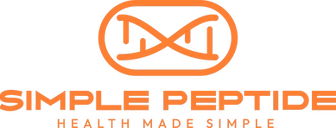Peptides 101: How to Open and Reconstitute Peptides

If you’ve just received your first peptide vials, you might be wondering exactly how to prepare them for research use. This straightforward guide will walk you through the process of safely opening and reconstituting lyophilized (freeze-dried) peptide vials.
What You’ll Need
Before starting, gather these supplies:
- The peptide vial (lyophilized powder)
- Bacteriostatic water (0.9% sodium chloride with 0.9% benzyl alcohol)
- Alcohol swabs
- Insulin syringes (typically 0.5ml or 1ml with 29-31 gauge needles)
- Optional: larger syringe for bacteriostatic water
- Clean surface to work on
- Refrigerator for storage
Step 1: Prepare Your Workspace
Start with a clean, flat surface. Wash your hands thoroughly or use gloves to avoid contamination.
Important: Peptides are delicate compounds. Work in a clean environment away from direct sunlight and heat.
Step 2: Opening the Peptide Vial
Peptide vials typically come with a flip-off cap and a crimp-sealed top. Here’s how to open vials from Simple Peptide:
Flip-Off Cap Vials:
- Locate the small plastic cap on top of the vial
- Hold the vial firmly on a flat surface or firmly in your hand
- Flip the cap off using your thumb (it’s designed to come off easily) – put your thumb under the edge and push up using the meaty part of your thumb
- This will expose the rubber stopper underneath
- The rubber stopper has a small circle that you’ll inject through
- Do not remove the entire metal crimped edge
Step 3: Reconstituting Your Peptide
Now you’ll add bacteriostatic water to dissolve the peptide powder:
- First, determine how much bacteriostatic water to add based on your designed concentration and research needs
- Clean the rubber stopper with an alcohol swab and let it dry
- Draw the appropriate amount of bacteriostatic water into your syringe
- Slowly inject the water INTO THE SIDE of the vial, letting it run down the glass
- IMPORTANT: Do not inject directly onto the peptide powder as this can damage the peptide structure
- Remove the needle, gently swirl or roll the vial (don’t shake vigorously)
- Shaking creates foam and can damage peptide bonds
- Swirling/rolling helps the powder dissolve gradually
- Continue gently swirling until the solution is completely clear
- Some peptides dissolve immediately
- Others may take 5+ minutes of occasional gentle swirling
- The solution should be clear when fully dissolved
Step 4: Storage After Reconstitution
Once reconstituted:
- Store your peptide vial in the refrigerator (2-8°C/36-46°F)
- Not the freezer – freezing after reconstitution can damage peptides
- Not at room temperature – this accelerates degradation
- Most reconstituted peptides remain stable for about 4-8 weeks when refrigerated
- Always check the vial before each use – the solution should remain clear
Common Questions
Q: Why is my peptide not dissolving completely? A: Some peptides take longer to dissolve than others. Continue gentle swirling and give it time. If it still hasn’t dissolved after 15 minutes, you may need to let it sit in the refrigerator for a few hours, then try swirling again. Some peptide compounds are hydrophobic
Q: Can I use regular water instead of bacteriostatic water? A: No. Bacteriostatic water contains benzyl alcohol which prevents bacterial growth. Using regular water will likely lead to contamination and peptide degradation.
Q: What if I accidentally inject water directly onto the peptide powder? A: The peptide should still be usable. In the future, remember to inject down the side of the vial.
Q: What if my peptide gels or clumps during reconstitution? A: Some peptides may sometimes look cloudy, and this is completely normal. Our recent switch to a US-based lab means we’re committed to producing peptides like Retatrutide, AOD9604, and Ipamorelin/CJC without any fillers. These peptides are naturally hydrophobic—they don’t fully dissolve in water unless the pH is adjusted or fillers are added.
Before using it, simply roll the vial between your fingers to help evenly distribute the product.
Safety Reminders
- All peptides are for research purposes only
- Always use sterile supplies and clean technique
- Never share needles or syringes
- Dispose of syringes properly according to local regulations
- Store all supplies out of reach of children
By following these simple steps, you’ll be able to properly reconstitute your peptides for optimal research results.
Featured products
-
Bacteriostatic Water 30ML
$15.00 -
BPC-157/TB-500 Blend 5/5MG
$55.00 -
CagriSema 10MG/10MG
$185.00Original price was: $185.00.$178.00Current price is: $178.00. -
GHK-CU 100MG
$55.00Original price was: $55.00.$50.00Current price is: $50.00. -
GLP-1SG 10MG
$93.00Original price was: $93.00.$83.00Current price is: $83.00.






